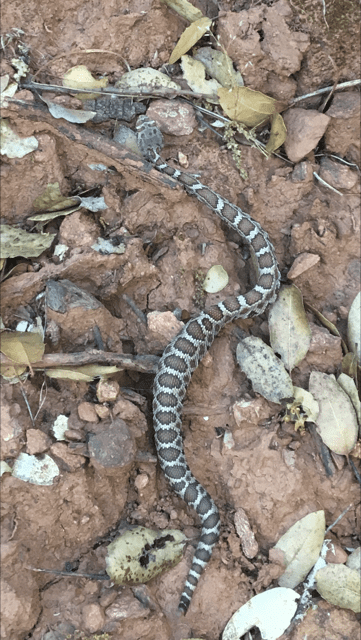| You never know what you will run into on a hike or walk. While hiking on Dragoon Trail in Sonora yesterday, I encountered this snake! Just a friendly reminder to be mindful of your surrounding’s this summer!
Photo: Julie Stabelfeld |
How to Be Rattlesnake Safe!
Source: Courtesy of the CDFW California Department of Fish & Wildlife
| With the coming of spring and warmer weather conditions, snakes of many species are through hunkering down, making human encounters with these elusive creatures more likely. Although most native snakes are harmless, the California Department of Fish and Wildlife (CDFW) recommends steering clear of the venomous rattlesnake – and knowing what to do in the event of a strike.
Rattlesnakes are widespread in California and are found in a variety of habitat throughout the state from coastal to desert. They may also turn up around homes and yards in brushy areas and under wood piles. Generally not aggressive, rattlesnakes will likely retreat if given room or not deliberately provoked or threatened. Most bites occur when a rattlesnake is handled or accidentally touched by someone walking or climbing. On rare occasions, rattlesnake bites have caused severe injury – even death. However, the potential of encountering a rattlesnake should not deter anyone from venturing outdoors. The California Poison Control System notes that the chances of being bitten are small compared to the risk of other environmental injuries. Most bites occur between the months of April and October when snakes and humans are most active outdoors, but there are precautions that can and should be taken to lessen the chances of being bitten. The dos and don’ts in snake country: Rattlesnakes are not confined to rural areas. They have been found in urban areas, on riverbanks and lakeside parks and at golf courses. The following safety precautions can be taken to reduce the likelihood of an encounter with a rattlesnake.
Rattlesnakes belong to a unique group of venomous snakes known as pit vipers and the rattlesnake is the only pit viper found in California. The copperhead and water moccasin also belong to this group; however, they are most commonly found in the southern, southeastern and eastern part of the United States. The term “pit” refers to special heat sensors located midway between the snake’s eye and nostril. These special thermoreceptors detect differences in temperature which help the snake pinpoint prey while hunting. The term “viper” is short for Viperidae, the family in which scientists categorize the rattlesnake. Pit vipers are venomous and rely on the use of venom to kill prey to eat. The rattlesnake’s prey of choice is chiefly rodents and other small mammals and this is an important factor in terms of keeping rodent populations in an ecosystem in check. Keeping snakes out of the yard: The best protection against rattlesnakes in the yard is a “rattlesnake proof” fence. The fence should either be solid or with mesh no larger than one-quarter inch. It should be at least three feet high with the bottom buried a few inches in the ground. Slanting your snake fence outward about a 30-degree angle will help. Keep vegetation away from the fence and remove piles of boards or rocks around the home. Use caution when removing those piles – there may already be a snake there. Encourage and protect natural competitors like gopher snakes, king snakes and racers. King snakes actually kill and eat rattlesnakes. What to do in the event of a snake bite: Though uncommon, rattlesnake bites do occur, so have a plan in place for responding to any situation. Carry a cell phone, hike with a companion who can assist in an emergency and make sure that family or friends know where you are going and when you will be checking in. In the event of a bite:
What you should NOT do after a rattlesnake bite:
More information about rattlesnakes can be found at the following websites: California Department of Fish & Wildlife Habitat and Relationships: www.wildlife.ca.gov/Data/CWHR/Life-History-and-Range UC Davis Integrative Pest Management: www.californiaherps.com/info/rattlesnakeinfo.html
|

